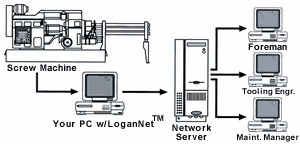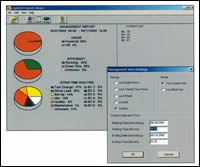Networking Your Multi-Spindles
This Ohio shop is looking forward to major benefits from real-time data acquisition.
Most screw machine shops still collect production data the old-fashioned way: Someone walks around the shop with a clipboard and a dull number two pencil scratching down part counts, time of day and similar information about each of the machines. Job status, efficiency, material needs and deadline information can then be determined. Reports are drawn up. Eventually, the production data makes its way to the front office and into the hands of the people who need it to make decisions. Of course, someone has spent a good part of the day doing all of this—someone whose time could be better spent.
At Alco Manufacturing (Elyria, Ohio), this is no longer the case. The company is in the process of installing a screw machine network that will automatically collect production information from the shop’s multi-spindle screw machines, organize it, prepare reports from it and make that information available to everyone who needs it. The network will run 24/7, continually updating the information and keeping everyone empowered with current and accurate production data.
Featured Content
Most of Alco’s 80-odd Acme Gridley multi-spindle machines are equipped with a CS 2001 microprocessor control made by Logan Clutch Corp. (Cleveland, Ohio). The control uses an absolute shaft encoder to monitor the multi-spindle screw machine’s drum shaft position in real time. Using the touch pad of the control, operators and setup people can enter positions for high point, low point, pick-off point, thread check and other important settings and view them on the control screen.
With the control, shift points can be set at optimum positions—there is no more need to settle for shift points that are “close enough.” Because high speed and brake cams need not be re-timed, setup time is further reduced. The control monitors lubrication pressure, coolant pressure and air pressures; shuts down the machine when the bar being fed becomes too short to feed out to length; detects broken tools; and more. It also has a JobSaver feature that that permits the company to save the settings for hundreds of jobs for future use.
The control also provides the connection to a gateway PC running LoganNet, a data collection and networking program developed by Logan Clutch for multi-spindle screw machines, on the shop floor. Alco is in the process of hard-wiring five machines to the PC running LoganNet, and the company will network the shop’s other multi-spindles as time and opportunity permit.
The multi-spindles and the gateway PC transmit messages to each other using a proprietary protocol. The transport technique used for these messages will tolerate the total loss of the physical layer for at least 2 days (often more, depending on the machine’s activity) without loss of data. Besides being fault-tolerant, the protocol also supports a 16-bit, error-checking technique that virtually eliminates the chance that corrupted data will be received by the PC.
The screw machines use the protocol to report machine events to the PC. These events track machine starts, stops, alarms, part counts and so on. Pretty much everything of interest on a screw machine is time-stamped and saved into a log file. Log files are continually updated and can be archived, copied and shared. By granting read access to individual PCs, the log files can be made available to users of the office LAN, and they can even be sent to remote locations.
The data in the log files is used to automatically generate reports on usage, efficiency and downtime analysis. The user does not need to set up anything other than the floor plan. A pie chart can be pulled up for a single machine or for a bank of machines running the same job. With one menu selection, all of the machines can be selected into the bank list to supply a plant-wide view of usage, efficiency and downtime analysis. The reports can be configured for a shift, day, week or any user-defined time span.
Helps Reduce Setup Times
The software supplies additional functionality for viewing event log files and storing and programming screw machine setups. This last feature reduces job setup time by automating control setup parameter programming. Jobs can be uploaded, saved, modified, re-named and downloaded to waiting screw machines. All of this can be accomplished in seconds. Event log viewing lets the user surf the log for a blow-by-blow description of each machine’s history.
The data saved in log files can also be exported into the common .csv (comma separated variables) format read by Excel, Access and many other desktop applications. This makes the information immediately available to the office software, and any report that management needs can be generated automatically.
The LoganNet server software running on the gateway PC also keeps current operating status of any machines connected to the network. The current status lets the user view the machine condition (running, stopped or alarmed) in real time. It also allows the user to view other pertinent screw machine data such as parts count, cycle time and run time. The exact cause of any alarm is annunciated along with the machine’s number and name. Because the information is continuously updated, a viewer can actually watch the parts count tick off on all of the machines at the same time. If a machine stops, the network informs the viewer within seconds with a detailed message about the alarm that stopped the machine.
Saves Time And Effort
A screw machine network can keep managers informed of important production information, especially usage, efficiency and parts count. It provides the information continuously without human intervention, keeping foremen, supervisors and other managers constantly updated. Acting as a usage and efficiency meter connected to every machine in the plant, the network can tell if a machine or a bank of machines is running profitably or losing money.
Nicole St. Marie, IT manager for Alco Manufacturing, explains some of the benefits that the company expects from networking its multi-spindle machines: “Our operators will be able to use the information provided by the system to gage their own performance for a given period,” she notes. “For example, an operator will be able to compare the amount of time spent on setups this week or month to previous periods and see whether and where improvements need to be made. Management will be able to use the same performance data for employee reviews.
Keeps Foremen Better Informed
“Our company has been growing,” Ms. St. Marie continues. “That has made it increasingly difficult for our foremen to get around to every machine to keep tabs on what’s going on. By networking the machines, our foremen will be able to check a PC located on the shop floor and see which machines are running and which are not. When a machine isn’t running, the foreman will be able to pull up more specific information that will indicate that the machine is idle because it’s being set up for the next job, or it’s being restocked, or that there’s a maintenance issue. Knowing what’s going on throughout the shop in real time will enable our foremen to identify problems as they arise and appropriately deal with them.
“For example, our employees must enter codes indicating the reasons that they shut down a machine,” Ms. St. Clair says. “Using that information, we’ll be able to analyze the problems that employees are having with particular jobs, whether there’s a machine problem, or a problem with the way the job is laid out, or an employee problem, and help us implement a meaningful solution.
“Looking a bit further down the road, we expect to connect the LoganNet to our scheduling software so that we’ll have real-time production figures,” she concludes. “Currently, once a day, we count machine hours to calculate our part counts. With LoganNet, each time a part is produced, the information goes directly into our schedule and counts down the time remaining for the job. Having more timely and more accurate production figures will help us make our scheduling more accurate as well.
“We can see a lot of advantages in being able to monitor our multi-spindles on a real-time basis, and so we’re looking forward to the time when all of our machines are included in the network,” Ms. St. Clair concludes.
RELATED CONTENT
-
How to Get More Efficient Production from Swiss-Type and Multitasking Machines
SolidCAM for multi-axis Swiss type and multitasking machines provides a very efficient CAM programming process, generating optimal and safe Mill-Turn programs, with dramatically improved milling tool life.
-
Winning New Jobs With Online Bidding
The digital revolution is hitting the business of the multiple-spindle automatic machining--in two distinct forms, no less. Twenty-five years after the first wave of digitization in manufacturing (numerical control) its linear descendant, computer numerical control or CNC, is changing the way screw machine shops do business.
-
Making Parts on a Swiss/Laser Machine
Adding laser cutting to Swiss-type machining is helping this shop do more work for its customers in the medical industry.









